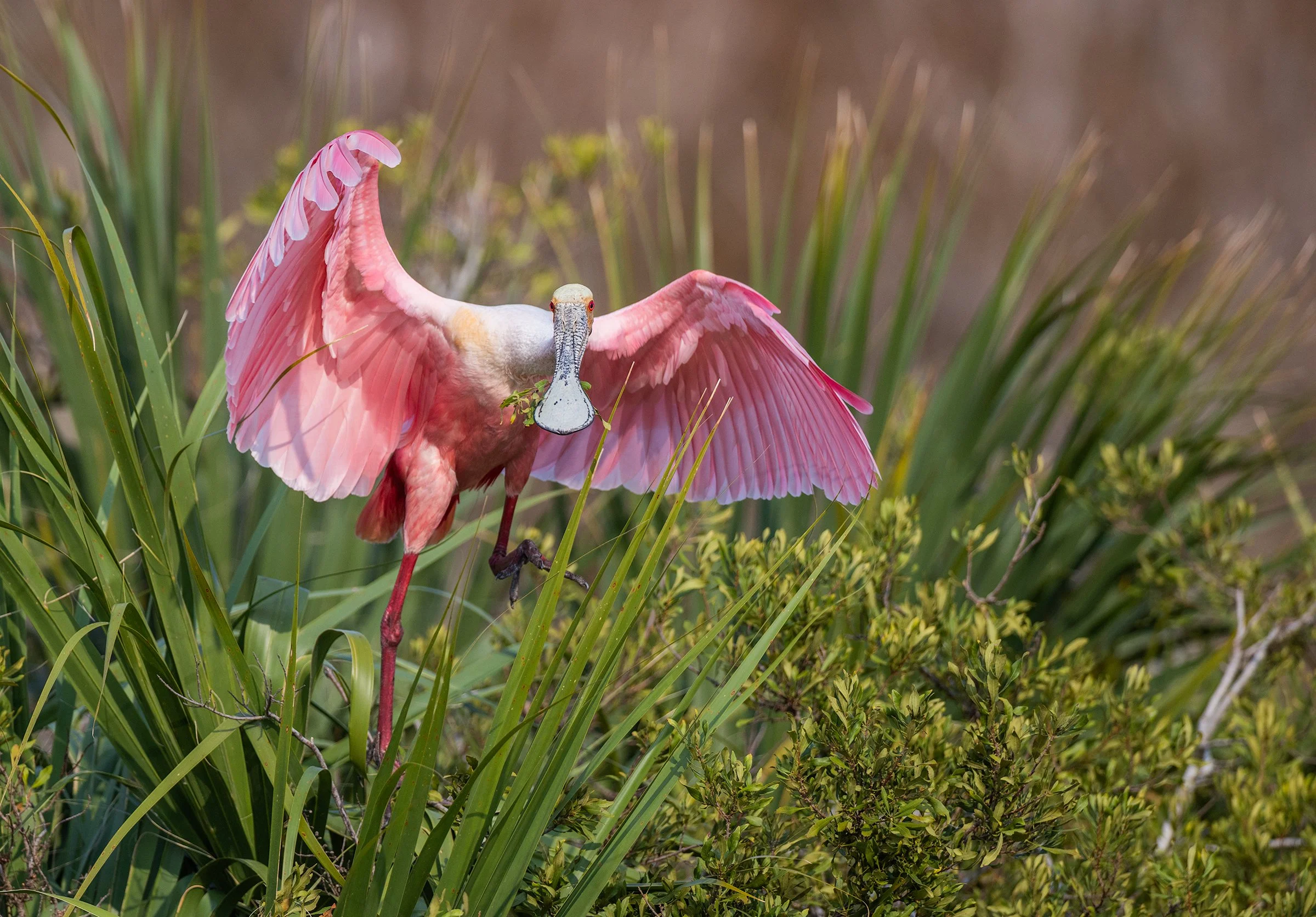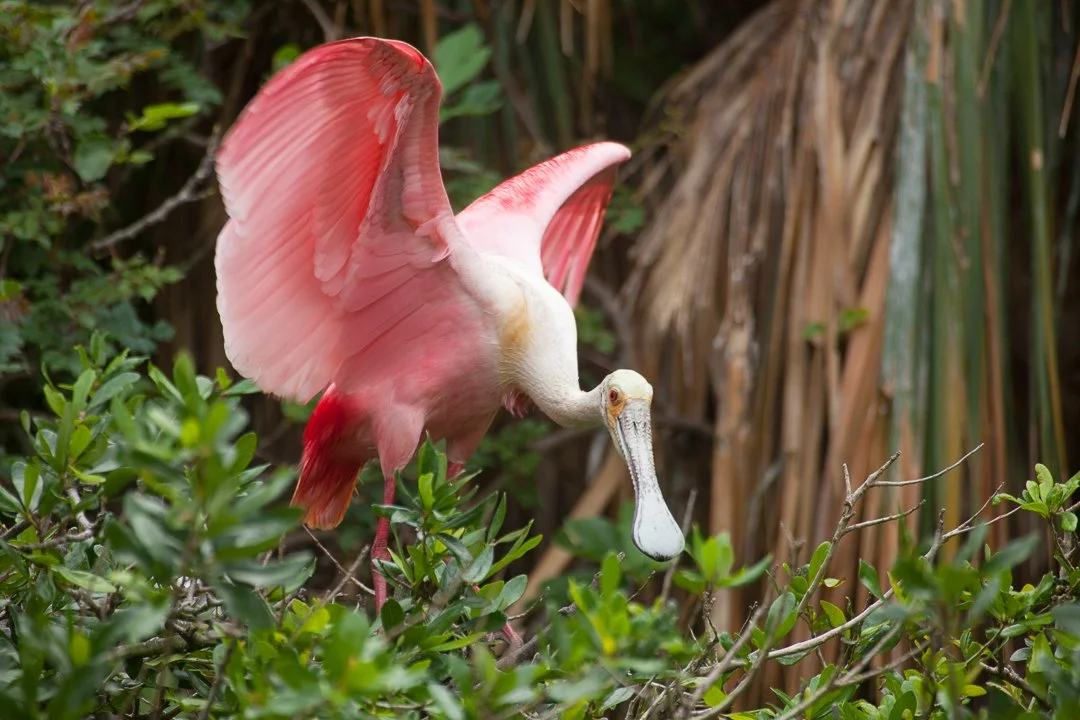Life in the Wetlands: Roseate Spoonbills
The Roseate Spoonbill (Platalea ajaja) is one of the most striking birds in North America. With its vivid pink plumage and unmistakable spoon-shaped bill, this species brings a splash of color to coastal wetlands and estuaries. They thrive in warm, shallow waters where small fish and crustaceans are plentiful. Watching them feed, fly, or display in the soft Florida light is a highlight on our tours, especially during the early morning hours when their colors glow.
Roseate spoonbill gathering twigs and branches for its nest, carefully arranging each piece in the mangroves during breeding season.
A close look at the delicate shades of pink and white in a roseate spoonbill’s plumage.
Nine Fun Facts About Roseate Spoonbills
Their color comes from their diet. Roseate spoonbills get their pink color from the crustaceans and other aquatic invertebrates they eat, which contain pigments called carotenoids, similar to flamingos.
Their spoon-shaped bill is perfectly designed. Their wide, flat bill allows them to sweep through shallow water with side-to-side motions, feeling for small fish, insects, and crustaceans rather than relying on sight.
They are one of only six spoonbill species in the world. While most spoonbills live in Africa, Asia, or Australia, the roseate spoonbill is the only one native to the Americas.
They nest in colonies with other waterbirds. You will often find them nesting alongside herons, egrets, and ibises, usually in mangroves, shrubs, or trees over water.
Young spoonbills are not pink right away. Juveniles are pale white with a hint of yellow, gaining their pink color as they mature and their diet changes.
Their breeding plumage is spectacular. During the breeding season, their feathers deepen to a vivid rose with touches of orange and red, especially on the shoulders and tail.
They are strong fliers with graceful formations. Roseate spoonbills fly with their necks and legs fully extended, often gliding in loose V-shaped groups.
They were once nearly wiped out. In the 1800s, they were heavily hunted for their colorful feathers, which were used in the fashion trade. Conservation efforts have helped their populations rebound, particularly in Florida.
They are a favorite among photographers. With their color, elegance, and distinctive bill, roseate spoonbills are one of the most photogenic birds in North America, especially in the early morning or late afternoon light.
Where We See Spoonbills on Our Tours
We often photograph roseate spoonbills on our Florida Bird Photography Tours, where we spend time in wildlife-rich wetlands and coastal habitats. They are most active in the early morning and late afternoon, wading through shallow lagoons and tidal flats. During nesting season, we sometimes capture them in flight carrying sticks and twigs back to their colonies, where they build nests high in mangroves or low in shrubs over water. Seeing a group of spoonbills feeding together, heads sweeping in perfect rhythm, is always a highlight. Occasionally, we encounter them alongside herons, ibises, and egrets, offering diverse opportunities for both behavioral and flight photography.
Conservation Status
Roseate spoonbills are listed as Least Concern globally by the IUCN, with stable populations across much of their range. In the United States, their numbers have rebounded significantly since the days when they were nearly wiped out by plume hunting in the 1800s. In Florida, they are classified as a Threatened species at the state level due to habitat loss, pollution, and changes in water flow that affect their feeding grounds. Continued protection of wetlands and coastal ecosystems remains essential to maintaining healthy populations.
Roseate spoonbills are listed as Least Concern globally by the IUCN, with stable populations across much of their range. In the United States, their numbers have rebounded significantly since the days when they were nearly wiped out by plume hunting in the 1800s. In Florida, they are classified as a Threatened species at the state level due to habitat loss, pollution, and changes in water flow that affect their feeding grounds. Continued protection of wetlands and coastal ecosystems remains essential to maintaining healthy populations.
Tips for Spotting and Photographing Spoonbills
Best times: Early morning and late afternoon, when the light enhances their pink tones.
Where to look: Shallow wetlands, tidal lagoons, and coastal estuaries, especially in southern Florida.
Photography tip: Use a long lens to fill the frame without disturbing the birds. Watch for the moment they lift their heads mid-sweep or stretch their wings when the light catches their plumage. With their oversized spatula-shaped bills, elegant neck curves, and wide wingspan, roseate spoonbills create striking silhouettes that are instantly recognizable and visually captivating against golden skies.
Composition: Include reflections, nearby mangroves, or other wading birds for added context and color.

























